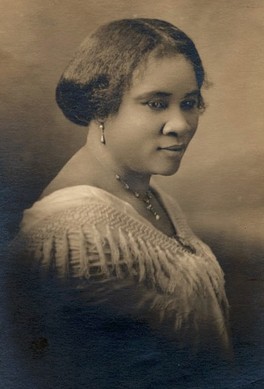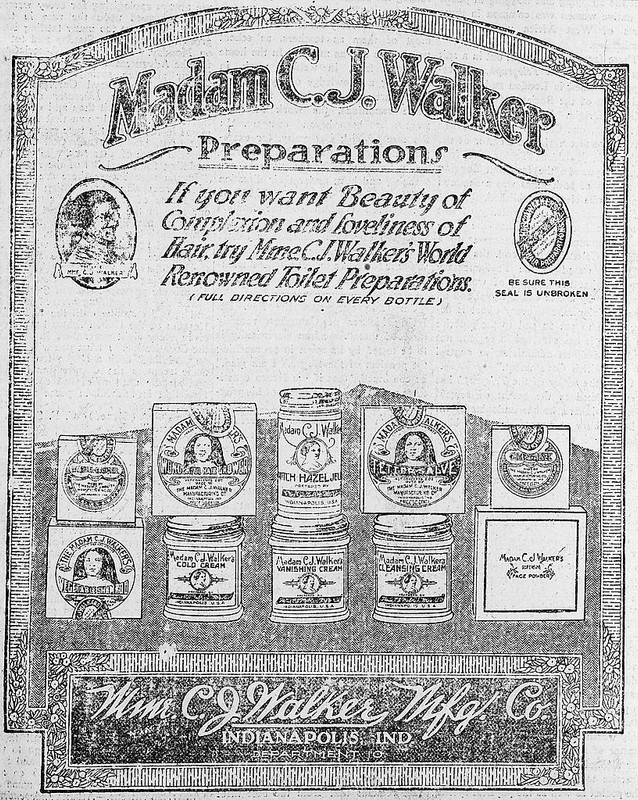Madam C.J. Walker House
Introduction
Text-to-speech Audio
Images
Portrait of Madam C.J. Walker

Madam C.J. Walker Manufacturing Co. Advertisement

Backstory and Context
Text-to-speech Audio
Madam C.J. Walker was born Sarah Breedlove in Louisiana in 1867. Her parents were former slaves who spent their few years of emancipated life as sharecroppers before they suddenly orphaned their daughter around the age of seven. After working on the plantation for three more years, she was passed along to one of her sisters and her less than willing husband, a violent man with a strong temper who saw Sarah as a burden. Sarah grew up as Reconstruction was failing. With no school for Black boys or girls in the area, she was forced to earn her keep in the home by doing chores like the washing. At only 14, she married a man Moses McWilliams to escape. A little over three years later, in 1885, she gave birth to a daughter named A'Lelia. Sarah was only 17. Tragedy struck her life yet again when she was left a widow at 20 with a young daughter to feed.
That year, 1887, she and her two-year-old daughter hopped on a steamboat heading from Louisiana to St. Louis and to joined her three brothers who worked in the city as barbers. She supported her small family by working as a washerwoman, taking in the measly sum of $1.50 per day. It wasn't much, but it allowed Sarah to send A'Leila to public school. (The public schools had a tuition because the city's elite did not want their children looked down upon for going to school for free like an orphan or a street urchin.) She settled into life in St. Louis, religiously attending the St. Paul African Methodist Episcopal Church (the second oldest Black church in the city), pursuing her education through night school classes, and actively participating in church clubs. Contact with St. Louis's middle class Black community pushed Sarah to work to better her family's lives. Remarkably, she was able to save enough to send A'Leila to Knoxville College in Tennessee so she could get the education her mother and enslaved ancestors never had.
In 1894, Sarah married again, this time to a man named John Davis. Unfortunately, it was not much happier. Davis was abusive, suffered from alcoholism, and was addicted to gambling. Even before the two separated, Sarah began seeing a new man - Charles Joseph (C.J.) Walker. Walker was radically different than Davis; he had his life together. Walker had made a good living for himself in the newspaper business as a salesman. In 1906, Sarah married him, despite still being married to Davis. She then started going by the name she is famous as - Madam C.J. Walker.
During her time in St. Louis, Walker's hair began to fall out. Years of hard work and an insufficient diet caused her to develop alopecia. The few hair care products designed for African American hair types available at the time were chock full of harmful chemicals that often burned women's scalps. Sarah would later claim that her recipe for a gentler and more effective hair care product came to her in a dream after she prayed and prayed for a solution to her hair woes. However, it's likely that her product was developed through experimentation during her time working as a hairdresser and saleswoman for another local hair care entrepreneur, Annie Turnbo Pope (later known as Annie Turnbo Malone).
In 1905, Sarah moved to Denver, Colorado to live with her sister-in-law and nieces. Her career as a remote saleswoman for Annie Turnbo Pope was brief. Soon after arriving in Denver, she combined her hair care knowledge with her new husband's marketing skills and launched her own company, called the Madam C.J. Walker Manufacturing Company. While giving demonstrations and teaching classes on her new product, Sarah also had to work as a cook and a laundress and take in boarders to survive. In addition, her former boss was not happy to have a new competitor. Annie Turnbo Pope and Madam C.J. Walker created an intense rivalry. However, Walker's company soon took off and even surpassed Pope's.
In 1910, Madam C.J. Walker opened a massive manufacturing headquarters in Indianapolis, Indiana that created and shipped her products out to her network of training schools across the country and into the hands of her door-to-door saleswomen, known as Walker agents. Madam C.J Walker's business empire made her the first female self-made millionaire in America. However, it also cost her her marriage. Sarah's ambition far outpaced her husband's. In the end, she kept his name and her fortune. Walker did not hoard her money, though. She became a prominent philanthropist giving back to Black organizations. Her company also offered Black women the rare opportunity to serve in executive positions and better their own lives. Madam C.J. Walker died in 1919 in her thirty-four room mansion, just outside of New York City. She was only 51. Her daughter A'Leila, who had been an active participant in the Madam C.J. Walker Manufacturing Company from the beginning, stepped into her mother's footsteps and took over the reigns of the business.
Cite This Entry
Kelland, Lara and Lindsay Davis. "Madam C.J. Walker House." Clio: Your Guide to History. April 7, 2020. Accessed April 13, 2025. https://theclio.com/tour/1376/8
Sources
Beilke, Jayne R. "Madam C.J. Walker: Entrepreneur and inventor." In Great Lives from History: African Americans. Amenia: Salem Press, 2011.
Blundell, John. "Madam C.J. Walker." In Ladies for Liberty: Women Who Made a Difference in American History. New York: Algora Publishing, 2011.
Miller, Page Putnam. "Madam C.J. Walker Building: Succeeding as an Entrepreneur." In Landmarks of American Women's History. Oxford: Oxford University Press, 2003.
Spevacek, Robin. "Madam C.J. Walker." Cricket 44, no. 5 (2017).
Wright, John A. "Madam C.J. Walker." In Discovering African American St. Louis: A Guide to Historic Sites. St. Louis: Missouri History Museum, 2002.
National Museum of American History Archives
Library of Congress, Newspaper and Periodicals Collection, LC-DIG-ppmsca-02902

